![The Mohican Board! [Bumppo's Redux!] The Mohican Board! [Bumppo's Redux!]](images/wwwboard.gif) |
|
| Author |
 Topic Topic  |
|
|
James N.
Colonial Militia
   

USA

Bumppo's Patron since [at least]:
October 24 2007
Status: offline
|
 Posted - February 26 2012 : 5:55:25 PM Posted - February 26 2012 : 5:55:25 PM



|
It was two by the village clock,
When he came to the bridge in Concord town.
He heard the bleating of the flock,
And the twitter of birds among the trees,
And felt the breath of the morning breeze
Blowing over the meadows brown.
And one was safe and asleep in his bed
Who at the bridge would be the first to fall,
Who that day would be lying dead,
Pierced by a British musket-ball.
Contrary to Longfellow's version of events, Paul Revere never made it all the way to Concord the morning of April 19, 1775, but of course the British did, following the brief encounter with Parker's company on Lexington Common. When they arrived, they began to search the village for any military stores; after discovering a couple of hidden cannon, Major Pitcairn did the rest his "searching" in Wright's Tavern where he ate and drank a little. Because of this, the tavern is now marked as British "headquarters" during their short stay. As with most in the region, it had previously been the meeting-place for the local militia, who had meantime prudently withdrawn to a hill on the opposite side of the Concord River since they were outnumbered.
Image Insert:
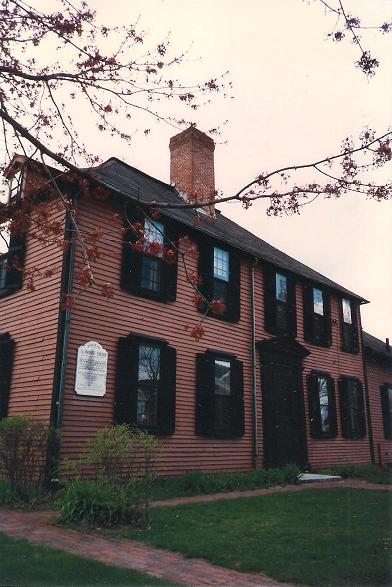
51.27KB
The village consisted of a few houses and other buildings grouped around a mill pond and at the southern edge of an east-west ridge, on which was the Hill Burying Ground. Lt. Col. Smith and Maj. Pitcairn supposedly climbed the ridge, from which they could see other militia companies approaching from various directions converging on the town.
Image Insert:
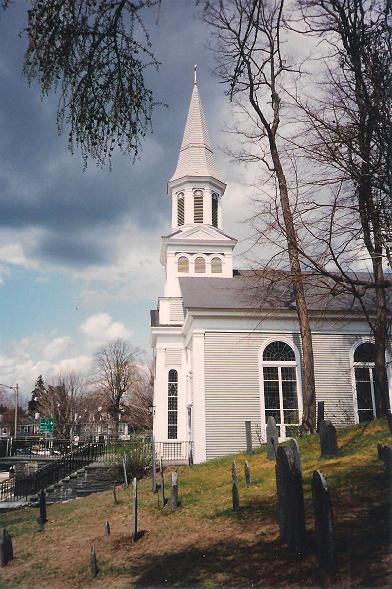
61.49KB
Image Insert:
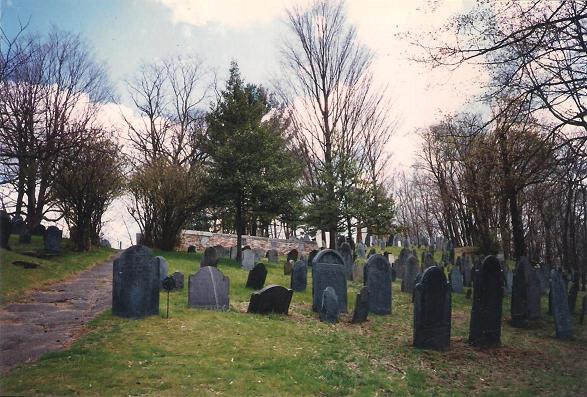
66.51KB
Hill Burying Ground dates from the Seventeenth Century, as shown by the tombstone of Robert Meriam, who died Feb. 15, 1681. The other stone is that of Jonathan Buttrick who died a month after the fight here on May, 18, 1775. Note the subtle change in monument carving styles that had taken place between these two; the typical winged skull, symbolic of death and transient, fleeting life common to Puritan beliefs had become a somewhat less pessimistic ( and threatening ) angel.
Image Insert:
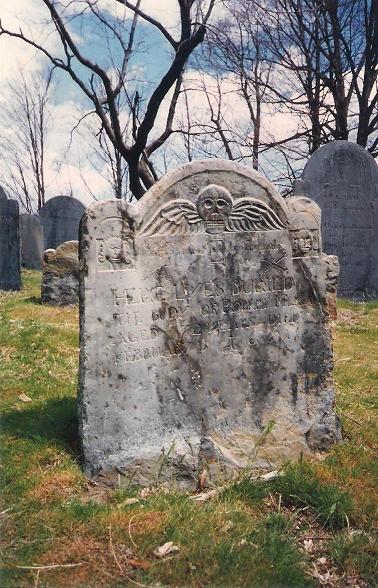
71.78KB
Image Insert:
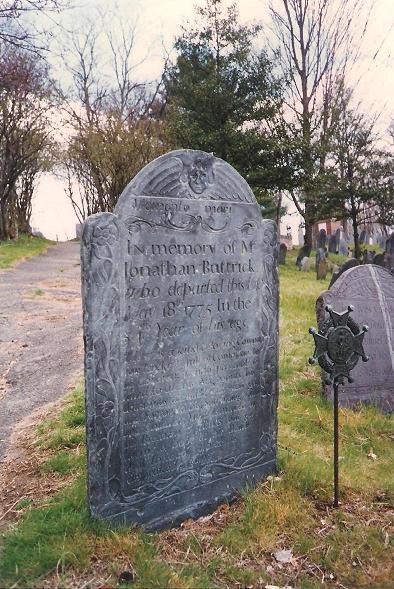
73.51KB
While the main body of Smith's force rummaged through Concord, smashing and burning some cannon carriages and dumping barrels of flour and musket balls into the mill-pond, other companies went to guard the two bridges on the small Concord River. The real target however, were the cannon said to be stored a few miles out in the country west of town on the farm of Col. Amos Barrett. In March of 1996, I found the farmhouse in sad condition indeed, in obvious need of paint and repairs. The only thing marking it as a significant historic site in any way was the plaque attached to the wall between the upper and lower windows on the right front of the house. Incongruently visible in a sunny west-facing upper window was a large collection of CACTUS plants!
Image Insert:

54.01KB
The four companies of British light infantry sent to Barrett's farm came up empty-handed here because the cannon ( barrels only, not mounted on carriages ) had been buried in the nearby fields. So they turned back the way they'd come; by the time they got back to the bridge, they found all Hell had broken loose!
|
|
report to moderator
|
|
|
James N.
Colonial Militia
   

USA

Bumppo's Patron since [at least]:
October 24 2007
Status: offline
|
 Posted - February 26 2012 : 6:51:04 PM Posted - February 26 2012 : 6:51:04 PM




|
Concord's own militia companies had withdrawn to a hill overlooking the town and the road over the bridge; from here they watched the British companies cross on the way to Barrett's farm and debated what to do while awaiting the reinforcements coming from nearby villages. Consternation grew in their ranks when they saw the smoke from the burning cannon carriages and other combustable stores, and they concluded the British were burning their town! Soon their number swelled to greater than that of the three British companies left guarding the bridge, and egged on by the more militant among them, they descended toward the bridge.
Image Insert:
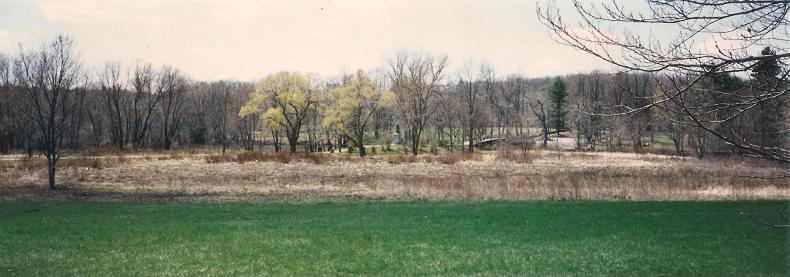
45.76KB
Overlooking the site on the south side of the bridge is the hilltop Old Manse, new in 1775, having been built in 1770 by Rev. William Emerson, grandfather of Ralph Waldo Emerson. Today it looks much as then, except for the dormer window added later in the 1840's. Nathaniel Hawthorne rented it for a time, living here before moving across town to The Wayside.
Image Insert:
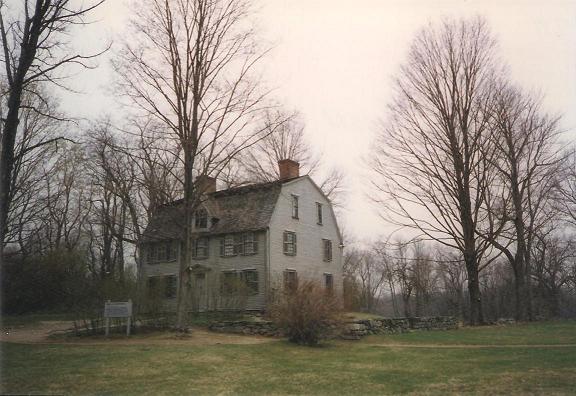
51.79KB
Image Insert:
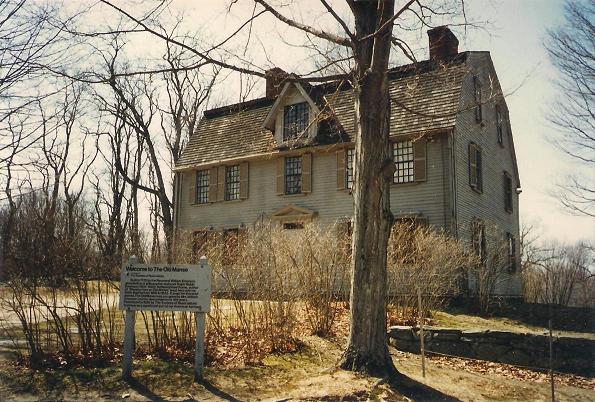
78.63KB
Rev. Emerson's frightened parishioners and neighbors gathered here for mutual protection, some taking refuge in the cellar; the more venturesome had a good view from the back of the house of events as they transpired down at the bridge.
Image Insert:

72.36KB
Image Insert:
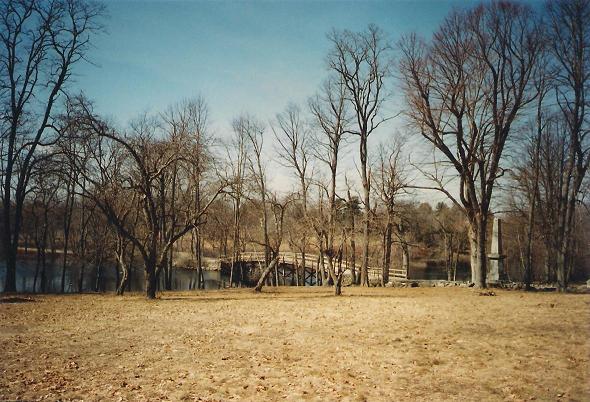
65.3KB
Following the Battles of Lexington and Concord, patriot Rev. Emerson became a military chaplain; unfortunately he died of "camp fever" Oct. 20, 1776, in Rutland Vt. while setrving as chaplain of New England troops there.
|
report to moderator  |
|
|
James N.
Colonial Militia
   

USA

Bumppo's Patron since [at least]:
October 24 2007
Status: offline
|
 Posted - February 26 2012 : 7:52:17 PM Posted - February 26 2012 : 7:52:17 PM




|
By the rude bridge that arched the flood,
Their flag to April's breeze unfurled;
Here once the embattled farmers stood
And fired the shot heard 'round the world!
View from the militia's approach; the road curves here, running left-to-right before turning left back towards the bridge. They advanced at a fast pace here toward the surprised British who were on the opposite side. Adopting an awkward tactical formation used for street fighting ( ! ) the light infantry got off a couple of volleys that generally went high; nevertheless a few on each side were killed and wounded, causing the British to withdraw back towards town and their main body.
Image Insert:

67.04KB
The first Concord monument, visible here on the other side of the bridge, dates from the 1830's; it was supplemented by the more famous one in 1875.
Image Insert:
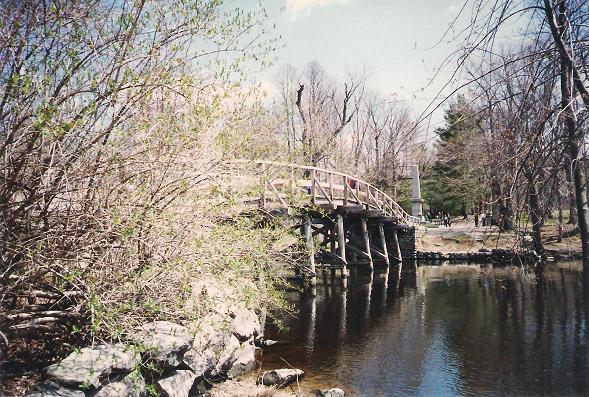
87.26KB
Image Insert:
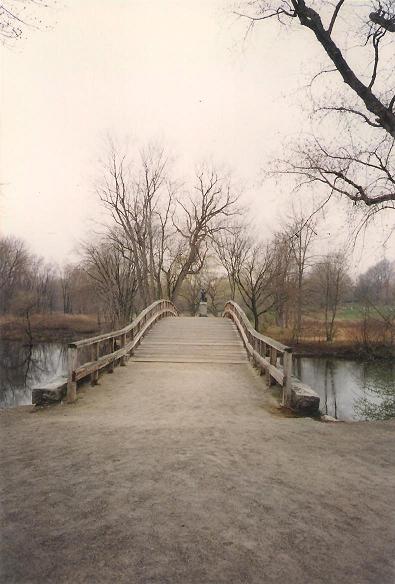
41.38KB
The famous Minuteman statue was cast for the Centennial from a sculpture by Daniel Chester French by the Ames Mfg. Co. of Springfield, Mass., makers of cannon, sabrers and swords during the Mexican War and Civil War. It was dedicated on the anniversary of the battle by Ralph Waldo Emerson, who for the occasion first read his Concord Hymn, above.
Image Insert:
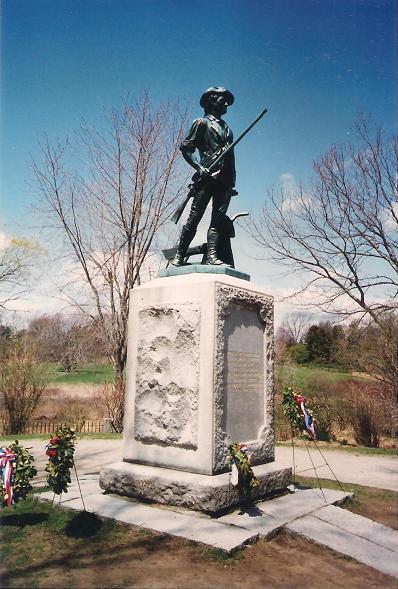
55.99KB
Image Insert:
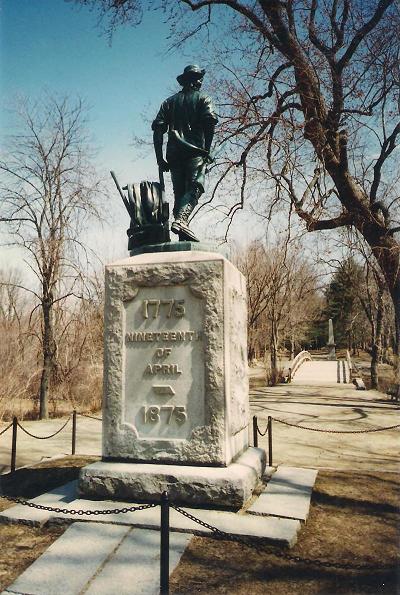
68.71KB
The Concord River is a quiet stream of little military significance that by chance entered history; today the two unknown British soldiers killed here still lie where they were buried in 1775. ( Note the Old Manse on the rise in the background. )
Image Insert:
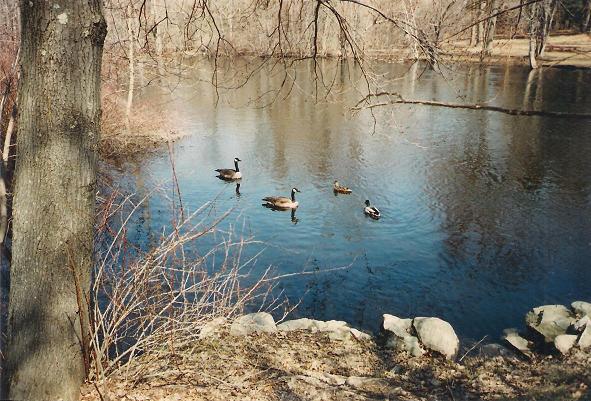
68.9KB
Image Insert:
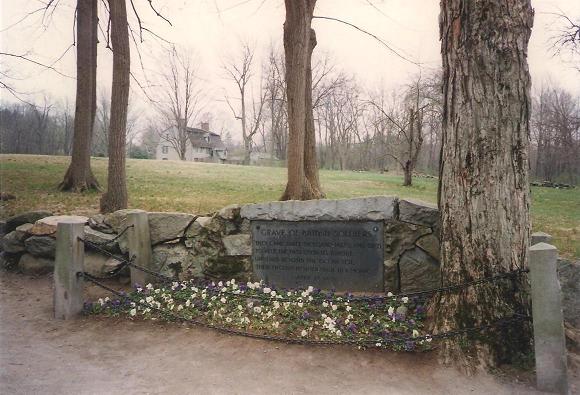
52.39KB
Nearby the Park Service maintains several houses, one a Colonial Revival dating from the early 1900's which servs as a museum and park headquarters for Minuteman National Historical Site. The farmhouse of Major John Buttrick, commander of Concord's militia companies stands nearby; here the bodies of those slain at the bridge were brought by their comrades.
Image Insert:
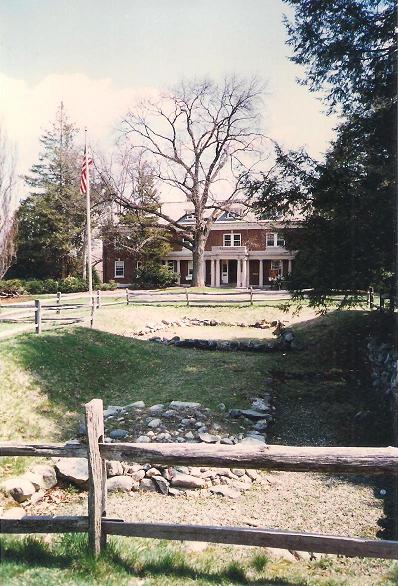
69.89KB
Image Insert:
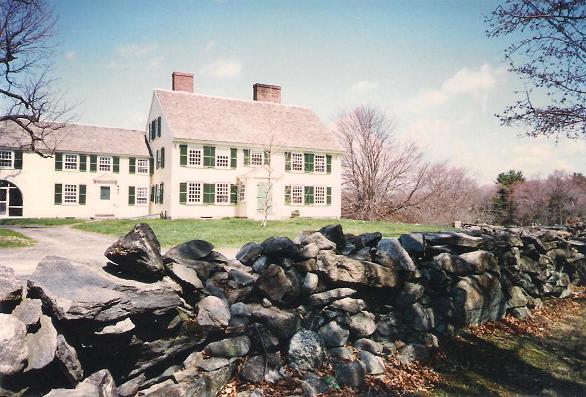
60.09KB
Instead of quickly pursuing the retreating British, once they saw Lt. Col. Smith leading up reenforcing grenadier companies, the militia also withdrew to a hill to await their own further reenforcements and developments. Amazingly, when the four companies that had gone to Barrett's farm returned, they were allowed to march unmolested to Concord. Meanwhile the fires of burning patriot stores had been extinguished by the British when locals complained of fire danger; how soon that attitude of cooperation was to vanish on the subsequent retreat!
|
report to moderator  |
|
| |
 Topic Topic  |
|
|
|
| The Mohican Board! [Bumppo's Redux!] |
© 1997-2024 - Mohican Press |
 |
|
| Current Mohicanland page raised in 0.25 seconds |
 |
|

![The Mohican Board! [Bumppo's Redux!] The Mohican Board! [Bumppo's Redux!]](images/wwwboard.gif)


